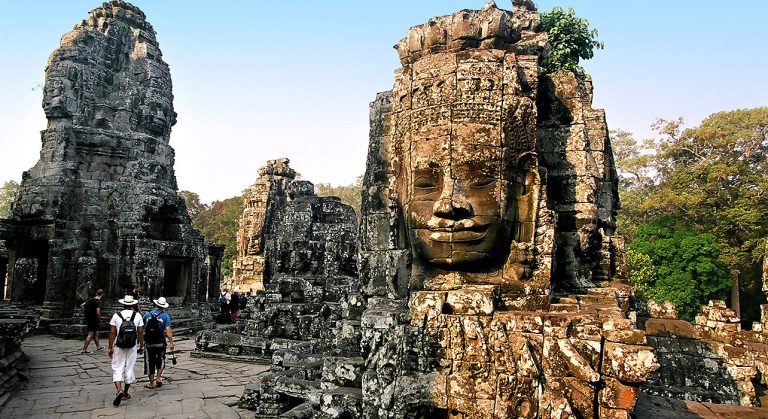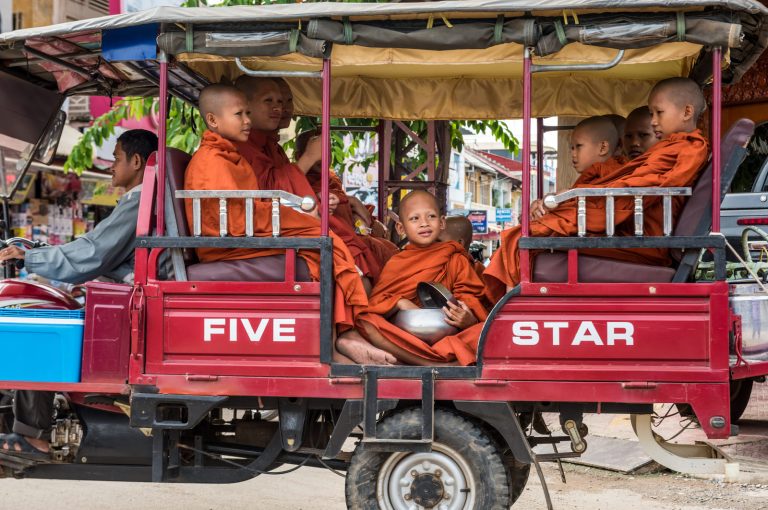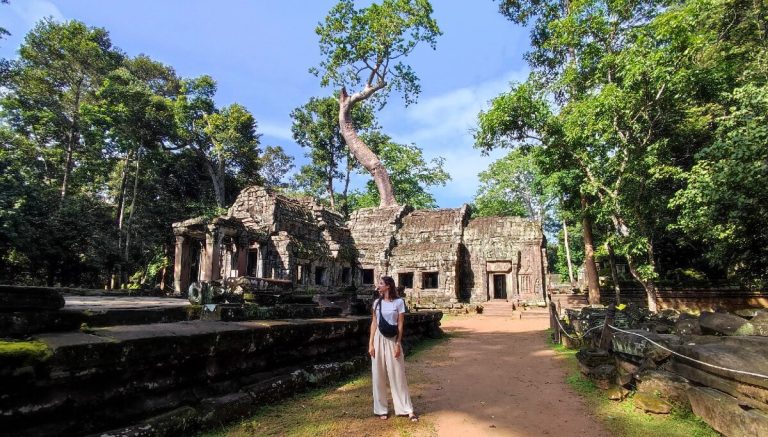Cambodia is a land of wonder, attracting millions of visitors each year with its awe-inspiring temples, stunning landscapes, and rich culture. However, one recurring concern for travelers is safety. With a mix of bustling cities and rural charm, the country presents unique experiences and challenges.
This guide will address key safety aspects for all types of travelers, including female tourists, highlight areas requiring extra caution, and provide essential tips for a smooth and memorable journey for tourists.
[caption id="attachment_4462" align="alignnone" width="768"] Is Cambodia Safe to Travel?[/caption]
Is Cambodia Safe to Travel?[/caption]
1. Is Cambodia Safe for Tourists?
Cambodia is generally considered a safe destination for tourists. The country has made significant progress in tourism infrastructure and security over the past decade. However, as with any travel destination, exercising caution and staying informed about local customs and practices is vital.
1.1. Is Cambodia Safe for Female Tourists?
Traveling solo as a female in Cambodia can be an enriching experience. It’s safe for female travelers to visit this country. The majority of Cambodians are warm, friendly, and welcoming so they are always available to help tourists, however, some situations may require extra vigilance.
It’s better for solo female tourists when traveling Cambodia:
- Dress modestly: In urban areas like Phnom Penh and Siem Reap, casual attire is perfectly acceptable, and tourists can feel free to wear light and comfortable clothes, but in rural areas and temples, covering your shoulders and knees is recommended.
- Stay in well-reviewed accommodations: Opt for hotels or hostels that have excellent reviews, particularly from other solo female travelers. Look for properties that emphasize security, such as those with 24/7 reception and secure locks.
- Use ride-hailing apps: Services like Grab or PassApp ensure safer transportation options compared to hailing tuk-tuks on the street. These services ensure fixed pricing and allow you to share your trip details with friends or family.
- Avoid late-night outings alone: While cities like Phnom Penh and Siem Reap have lively nightlife, it's safer to explore with a group or use reliable transportation.
Female travelers often find Cambodia welcoming, but being prepared and aware of your surroundings ensures a more enjoyable trip.
[caption id="attachment_13600" align="aligncenter" width="768"] A Comprehensive Guide for Tourists[/caption]
A Comprehensive Guide for Tourists[/caption]
1.2. A Few Places in Cambodia That Require Extra Caution
While Cambodia is mostly safe, specific regions or situations may pose risks. Here are a few areas where tourits should be more carefully:
1.2.1.Phnom Penh:
Phnom Penh is a big city where bag snatching. This is the most common petty crime in the capital so travelers should keep their bags close to their bodies, and avoid using their phone openly on the street.
1.2.2.Sihanoukville:
Once known for its beaches, Sihanoukville has undergone rapid development, leading to increased reports of scams and petty crimes. It’s better for tourists to stay alert in crowded areas and avoid leaving valuables unattended at the beach.
[caption id="attachment_13602" align="aligncenter" width="768"] Is Cambodia Safe for Female Tourists?[/caption]
Is Cambodia Safe for Female Tourists?[/caption]
1.2.3.Border with Thailand:
This region still has hidden landmines so it is essential to stick to well-traveled routes. The area surrounding the Preah Vihear temple, also known as Khao Phra Viharn in Thailand, has had a territorial dispute between Cambodia and Thailand. This border region has witnessed occasional clashes between the militaries of the two countries, As a result, travelers are strongly advised against visiting the Preah Vihear temple and its immediate vicinity.
After several days of intense clashes along their shared border, Thailand and Cambodia agreed to hold peace talks in Malaysia on July 28, 2025, following four days of fighting, according to BBC News. Cambodian Prime Minister Hun Manet stated, “Today we had a very productive meeting with promising outcomes, aiming to bring an immediate end to the fighting that has resulted in significant loss of life, injuries, and the displacement of many people.” With this agreement, the situation along the Cambodian-Thai border is expected to stabilize, ensuring safety for tourists traveling in the area.
2. What You Should Know Before Traveling
2.1. Currency in Cambodia
Cambodia's unique currency system operates on a dual-currency system, where both the Cambodian Riel (KHR) and the US Dollar (USD) are commonly used. While the Riel is the official currency, USD is widely accepted across the country, especially in tourist areas and major cities like Phnom Penh and Siem Reap. When managing money in Cambodia, it’s important to carry small denominations, as many vendors and tuk-tuk drivers may not have enough change for large bills.
Cambodian Riel is typically given as change for transactions made in USD, so it's useful to familiarize yourself with the exchange rate (approximately 4,000 KHR to 1 USD as of 2024). ATMs are readily available in urban areas and often dispense US Dollars, but for added security, it’s best to use ATMs located in major banks. While credit cards are accepted at upscale hotels, restaurants, and larger stores, cash remains the preferred method of payment in smaller establishments and for everyday transactions.
2.2. How to Get Around Cambodia
Getting around Cambodia is relatively straightforward, but the best mode of transportation depends on your specific travel plans, itinerary, and comfort level.
2.2.1.Local Transport:
- Tuk-tuks: The most common and convenient way to travel within cities like Phnom Penh and Siem Reap. You can either negotiate fares directly with the driver or use ride-hailing apps like PassApp, which offers a transparent pricing system.
- Motorbike taxis: Motorbike taxis, or "moto" taxis, are an affordable option for short distances, but they come with safety concerns, especially in heavy traffic. Note that helmets are often not provided, so it’s best to bring your own or ensure the driver offers one.
- Cycling: Renting a bicycle is a great way to explore smaller towns such as Kampot, Battambang, or even the vast Angkor Wat temple complex. The flat terrain makes cycling an enjoyable way to experience the countryside at your own pace.
[caption id="attachment_7360" align="aligncenter" width="768"] How to Get Around Cambodia[/caption]
How to Get Around Cambodia[/caption]
2.2.2.Intercity Travel:
- Buses and Minivans: Buses and minivans are an affordable means of traveling between cities, though schedules can be unpredictable. Reputable operators like Mekong Express and Giant Ibis offer comfortable rides with air conditioning and reliable service.
- Private Taxis: For those seeking convenience and more flexibility, private taxis are an excellent choice. While pricier, they offer door-to-door service and are ideal for groups or those with heavy luggage. Prices are negotiable, but it's a good idea to agree on the fare beforehand.
- Flights: If you’re short on time, domestic flights between Phnom Penh, Siem Reap, and Sihanoukville can save hours of travel, though they tend to be more expensive than other options. Cambodia Angkor Air and Lanmei Airlines are among the main carriers for domestic routes.
2.2.3.Pro Tips for Getting Around:
- Traffic: Traffic rules are often ignored, particularly in busy cities, so always exercise caution when crossing roads or driving. Be alert, as vehicles might not stop for pedestrians.
- Motorbike Rentals: While renting a motorbike is a popular option, be cautious if you lack experience with chaotic traffic. Driving in Cambodia can be challenging due to the high volume of motorcycles and the lack of clear road signs, especially in rural areas.
[caption id="attachment_13601" align="aligncenter" width="768"] Pro Tips for Getting Around Cambodia[/caption]
Pro Tips for Getting Around Cambodia[/caption]
3. Do’s and Don’ts in Cambodia for Tourists
When traveling to Cambodia, respecting local customs and traditions is essential for a positive and rewarding experience. While Cambodians are generally welcoming and hospitable, understanding their culture can help you avoid misunderstandings and potential pitfalls.
Do’s:
- Respect cultural norms: Cambodia is a conservative society, and dressing modestly shows respect for local traditions.
- Greet with a Sampeah: Placing your hands together in a prayer-like gesture and bowing slightly is a traditional greeting.
- Support ethical tourism: Choose tour operators and souvenirs that contribute positively to local communities.
Don’ts:
- Avoid discussing politics: Cambodians are proud of their heritage, but discussing sensitive topics like the Khmer Rouge era or current politics can be offensive.
- Do not touch monks: Women, in particular, should not touch or hand items directly to monks. Use a respectful intermediary approach.
- Don’t litter: Cambodia is working to combat pollution, and tourists can help by disposing of trash responsibly.
Conclusion
Is Cambodia safe to travel? Yes, Cambodia is safe and offers a wealth of experiences for every traveler, from the iconic Angkor Wat to the bustling streets of Phnom Penh. By staying informed and taking necessary precautions, you'll not only stay safe but also fully immerse yourself in the beauty and charm of this fascinating country. Is Cambodia Safe to Travel?[/caption]
Is Cambodia Safe to Travel?[/caption]
 A Comprehensive Guide for Tourists[/caption]
A Comprehensive Guide for Tourists[/caption]
 Is Cambodia Safe for Female Tourists?[/caption]
Is Cambodia Safe for Female Tourists?[/caption]
 How to Get Around Cambodia[/caption]
How to Get Around Cambodia[/caption]
 Pro Tips for Getting Around Cambodia[/caption]
Pro Tips for Getting Around Cambodia[/caption]